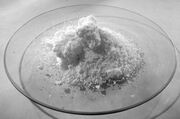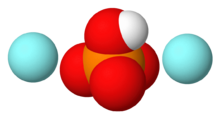Chemistry:Dipotassium phosphate

| |

| |

| |
| Names | |
|---|---|
| IUPAC name
Potassium hydrogen phosphate
| |
| Other names
Potassium monohydrogen phosphate
Phosphoric acid dipotassium salt Potassium phosphate dibasic | |
| Identifiers | |
| |
3D model (JSmol)
|
|
| ChEBI | |
| ChEMBL | |
| ChemSpider | |
| EC Number |
|
PubChem CID
|
|
| UNII |
|
| |
| |
| Properties | |
| K2HPO4 | |
| Molar mass | 174.2 g/mol |
| Appearance | white powder deliquescent |
| Odor | odorless |
| Density | 2.44 g/cm3 |
| Melting point | > 465 °C (869 °F; 738 K) decomposes |
| 149.25 g/100 mL (20 °C) | |
| Solubility | slightly soluble in alcohol |
| Acidity (pKa) | 12.4 |
| Basicity (pKb) | 6.8 |
| Hazards | |
| NFPA 704 (fire diamond) | |
| Flash point | Non-flammable |
| Related compounds | |
Other cations
|
Disodium phosphate Diammonium phosphate |
Related compounds
|
Monopotassium phosphate Tripotassium phosphate |
Except where otherwise noted, data are given for materials in their standard state (at 25 °C [77 °F], 100 kPa). | |
| Infobox references | |
Dipotassium phosphate (K2HPO4) (also dipotassium hydrogen orthophosphate; potassium phosphate dibasic) is the inorganic compound with the formula K2HPO4.(H2O)x (x = 0, 3, 6). Together with monopotassium phosphate (KH2PO4.(H2O)x), it is often used as a fertilizer, food additive, and buffering agent.[1] It is a white or colorless solid that is soluble in water.
It is produced commercially by partial neutralization of phosphoric acid with two equivalents of potassium chloride:[1]
- H3PO4 + 2 KCl → K2HPO4 + 2 HCl
Uses
As a food additive, dipotassium phosphate is used in imitation dairy creamers, dry powder beverages, mineral supplements, and starter cultures.[2] It functions as an emulsifier, stabilizer and texturizer; it also is a buffering agent, and chelating agent especially for the calcium in milk products..[3]
As a food additive, dipotassium phosphate is generally recognized as safe by the United States Food and Drug Administration.[4]
References
- ↑ 1.0 1.1 Klaus Schrödter; Gerhard Bettermann; Thomas Staffel; Friedrich Wahl; Thomas Klein; Thomas Hofmann (2012). "Ullmann's Encyclopedia of Industrial Chemistry". Ullmann's Encyclopedia of Industrial Chemistry. Weinheim: Wiley-VCH. doi:10.1002/14356007.a19_465.pub3.
- ↑ John H. Thorngate III, ed (2001). "Food Phosphates". Food Additives. Food Science and Technology. 116. CRC Press. doi:10.1201/9780824741709.ch25. ISBN 978-0-8247-9343-2.
- ↑ "What is dipotassium phosphate?". 30 April 2018. https://us.myprotein.com/thezone/supplements/dipotassium-phosphate-used/.
- ↑ "Database of Select Committee on GRAS Substances (SCOGS) Reviews". http://www.cfsan.fda.gov/~dms/opascogd.html. (listed as "potassium phosphate, dibasic")
 |


